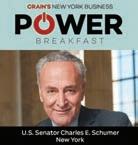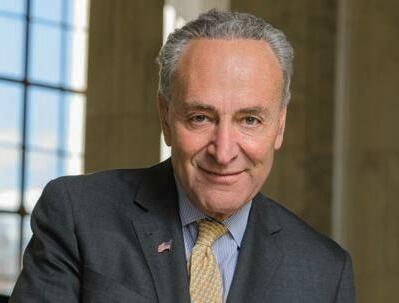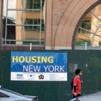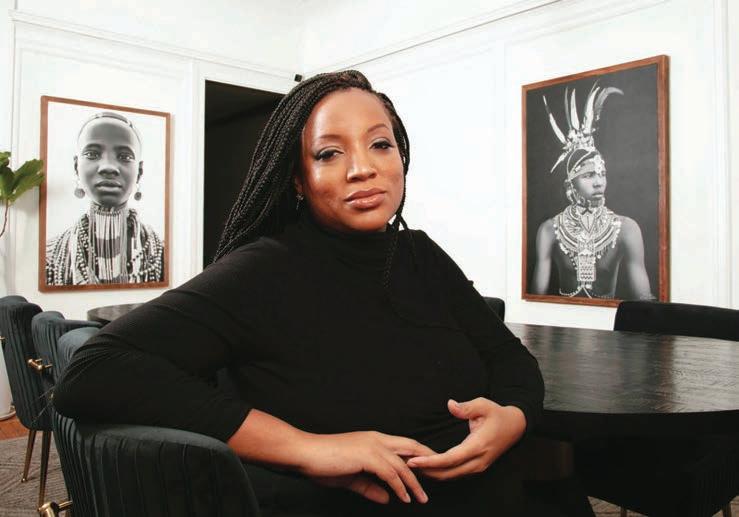Recovery meets slowdown: What to expect this year













 BY CARA EISENPRESS
BY CARA EISENPRESS
Union Square Ventures, a venerable 20-year-old venture-capital fund, halved the carrying value of its assets under management last year.
e fact that USV, arguably the city’s leading VC investor, had such a down year bodes poorly for the rest of the sector, though the writedowns are not exactly a surprise given the state of the cryptocurrency industry.
“I understand that this year has been painful for most and devastating for many,” USV co-founder Fred Wilson wrote toward the bottom of a year-end summary on his frequently updated blog, avc.com. “I am not immune to it.” He added that his family’s net worth also has taken a “massive hit.”




e rm has $1.5 billion in assets under management, and its funds have stayed within the $200 million to $300 million range even as plenty of VC rms deployed megafunds of more than $500 million in 2021. USV is known for early

Extell Development appears to have scored a major bargain on the Lower East Side amid a soft housing market and an ongoing legal fight.
The luxury builder has closed on the purchase of development site 259 Clinton St. in the Two Bridges neighborhood for $40 million, records show. The site, which is zoned for a 62-story, 706-unit tower, reportedly had been shopped for around $100 million—which suggests Extell enjoyed a hefty discount.
Some sources familiar with the deal said the actual asking price
and neither did Extell. Eastdil Secured, which marketed the property, also declined an interview request.
The purchase of the vacant property, which is at the corner of South Street, closed Dec. 30 and appeared in public records last Tuesday. Starrett broke ground on the site last year, which allowed it to qualify for tax abatements under the state’s 421-a program before the program expired in June.
The property, in an area lined with public-housing developments, is no stranger to real estate controversy.
City Council member Christopher Marte and 10 other residents in October headed to court to prevent the development of 259 Clinton and two other nearby skyscrapers for environmental reasons.
was closer to $60 million, but they declined to comment on the record. They added, however, that the price of land can fluctuate more broadly than with other kinds of real estate.
They added that requirements specific to Two Bridges projects, in terms of amenities and infrastructure improvements, effectively drive down the price of development sites.
The seller of the property, Starrett Development, had no comment,

“Each person shall have a right to clean air and water, and a healthful environment,” said their lawsuit, which invoked part of a new state law to make their case: last January’s “Bill of Rights.”
According to the suit, which is in state Supreme Court in Manhattan, asthma is a major health problem in the Two Bridges neighborhood, where 36% of residents live in poverty, and Covid-19 made their situation much worse.
Housing development has frequently met resistance in the neigh-
borhood, even as zoning allows tall towers. Marte’s father owned a bodega that “had to close down because of rent hikes, and Christopher started to see the community he loved get torn apart by luxury development and corrupt politicians,” says the councilman’s website. Marte declined to comment on an ongoing case.
Extell filed a motion last month to dismiss Marte’s case, records show. And Two Bridges developers have beaten legal challenges before.
In May 2021 the New York Court
of Appeals rejected an attempt by community groups to stop its projects. And a separate ruling by the same court halted an effort by Councilwoman Gale Brewer, then Manhattan borough president, and other officials to stop the developments for bypassing the city’s typical land-use-approval process.
Known for building even through downturns, Extell, which is helmed by Chairman Gary Barnett, might face headwinds in the sales market. The average price of a new condo in
Manhattan in the fourth quarter was $3.2 million, down 20% from the previous quarter, according to brokerage Douglas Elliman.
Slow sales have bedeviled a nearby Extell project, 1 Manhattan Square, an 815-unit tower at 252 South St. completed in 2019 on the site of a former Pathmark supermarket. Eight years after marketing began, the 80-story condominium has not sold out, despite several incentives, like the current one in which Extell says it will help pay down mortgage interest on home loans for several years. ■
Mark your calendar to hear U.S. Sen. Charles E. Schumer interviewed by Crain’s Editor-in-Chief Cory Schouten.

Find out how New York’s senior senator views the evolving political climate, how he gets big deals done in a divided Washington and what’s needed to keep the state’s recovery on track.
Time: 9 to 10:30 a.m.
Location: 180 Central Park S.
CrainsNewYork.com/pb_schumer
BY EDDIE SMALLThe latest round of awards from a state program will provide funding for as many as 5,000 supportive housing units across New York.
The Empire State Supportive Housing Initiative has given out 125 conditional awards to help organizations provide services and fund operating expenses for supportive housing geared toward senior citi-
billion plan to build or preserve 10,000 supportive housing units.
Organizations that received the money from the seventh round of the initiative include 29 in the city. The Bridge, BronxWorks, Comunilife, Community Access and the Institute for Community Living were among the groups that got awards. Comunilife said it will use the money to help fund its Tiebout Residence project, an 83-unit Bronx development that will feature 50 supportive housing units for the elderly, according to the group’s chief executive, Rosa Gil.
zens, domestic violence survivors, militar y veterans, chronically homeless families, and people with mental illnesses or substance abuse disorders. The awards are part of Gov. Kathy Hochul’s five-year, $25

The Institute for Community Living plans to use the funds to renovate the Variety Boys and Girls Club of Queens, which focuses on supporting young adults aging out of foster care, according to the organization.
The Hochul administration did
not specify how much award money each organization received.
The other winning organizations were split between seven on Long Island, 10 in the Mid-Hudson region, nine in the Capital District, eight in central New York, five in the Finger Lakes, five in the Mohawk
Valley, six in the North Country, three in the Southern Tier, and nine in western New York. Some of the organizations received multiple awards.
The awards are conditional and contingent on the projects being able to secure the ability to construct, adapt or renovate a supportive housing development. The award money is meant for rental assistance and services to help ensure housing stability, and the projects might get up to $25,000 per unit per year in funding.
The initiative has so far provided funding for more than 7,400 units. The first projects to meet the conditions of their award money are expected to spur the creation of up to 1,400 units ■

Trot, an Uber-like platform, connects building owners with companies seeking cheaper short-term leases
Like many New Yorkers in real estate, David Menaged had plenty of free time on his hands in the early days of the pandemic. But the commercial broker didn’t spend his shut-in days baking sourdough bread. He used the lull to create an online marketplace that connects building owners directly with companies seeking short-term o ce space.
His model cuts the coworking industry out of the equation.
Menaged knew nothing about tech, but he is a real estate veteran. e Brooklyn College dropout, who was raised in Flatbush, got started straight out of high school, interning with a small real estate company and going on to launch his own commercial brokerage, Intrepid Real Estate Group.
“I founded it in the last awful market—2008,” he says. “So my timing really stinks! Or it’s amazing. Depends how you look at it.”
e city’s short-term, ex-space o ce market had long struck him as a great opportunity. JLL predicts that 30% of all o ce space will be “ ex-leased” by 2030. But these days the market is dominated by the coworking industry, which leases large spaces at a deep discount from building owners, then subleases them to customers at a signi cant markup.
ninth oor at 240 Madison Ave. e rates, which are set by the building owners, are typically half what one might pay at a coworking space on a square-foot basis, Menaged says.
Scott Galin, CEO and a principal at Handro Properties, was among the rst to try the platform. Galin listed a number of o ce spaces in several buildings owned by his company, and he hopes it will prove to be an e cient way to ll selected short-term vacancies.
“Usually it takes comparable time, energy and logistics to do a small, short-term deal as a more traditional term of ve, seven or 10 years,” he says.
Galin’s listings have received only a few bites, but that’s by design. Menaged says he’s been looking to get more locations on the site before marketing to prospective tenants, “so that when people come to the platform, there’s real choices.”
munity.”
Trot’s rst big challenge was to persuade often conservative landlords to try the platform. While Menaged thinks the platform will go viral one day, the company is pitching building owners one by one through Zoom presentations and in-person demos.
“ e model is tremendously scalable,” he says, “but at the early stages, I think it needs to be treated like a local business.”
Menaged says he’s learned a lot in the process. Early on, he dropped the idea of providing tenant background checks— there’s too much potential liability.
“We’re the platform on which they nd the space, communicate with each other and transact,” he says. “But it’s up to the parties to be comfortable with each other.”
ANNE KADET
Menaged describes his startup, Trot, as an Airbnb or Uber for o ce space. Building owners list their spaces on the searchable platform for renewable, three-month terms. Tenants can take the space unfurnished or furnished. e company does not charge o ce owners a fee for listings, but it does charge a 10% commission on every transaction.
Trot, which launched in June, lists 166 spaces in 34 buildings, largely in Manhattan. e company’s available o ce space currently stands at 234,648 square feet. Rates range from $950 a month for a 60-square-foot o ce on West 40th Street to $20,600 a month for the entire 6,000-square-foot
New York City-based WeWork o ers exible-term workspace at more than 640 locations in 34 countries, serving lone freelancers, small businesses and Fortune 500 companies. Customers looking for ofce leases must sign for a minimum of six months. e company’s 2021 revenue topped $2.5 billion.
Menaged hired a small team of developers last year to start building an online platform. e developers were initially funded out of his own pocket. In March 2021 he raised a couple of million dollars from peers in the real estate business who share his vision.
One such investor, Abraham Kassin CEO of Kassin Sabbagh Realty, sees a lot of pitches from proptech companies.
“But this one really spoke to us,” he says. “We saw the need for something like this. … It gives the landlords the ability to control their own destiny, together with the brokerage com-
In October, Trot radically streamlined the onboarding process for landlords. e original process, which had everyone sending DocuSign agreements back and forth, proved unwieldy and took up to a month to complete. Landlords can now sign the agreements and list their property immediately.
Earlier in the fall, the company doubled down on its e ort to work with commercial brokers to attract new business, offering to split the 10% commission 50-50. It will soon allow building owners the option of o ering longer-term deals to prospective tenants.
Menaged launched Trot in New York City, where he has plenty of local knowhow and contacts. But now he’s planning to expand to other locations, such as Miami, Los Angeles and Austin, where he won’t enjoy those advantages.
But he’s not worried.
“Going into tech when I was a dumb real estate guy was a pretty big challenge also,” he says, “and I was up for that one!”■
It took a while. And it might take a while longer for others to follow suit.
But the city’s first legal marijuana retailer in NoHo is enjoying firedup customers, based on the steady lines that have formed outside Housing Works Cannabis since its Dec. 29 opening in the neighborhood.
Its popularity has heartened some landlords and brokers worried about the problem of empty storefronts. If a cannabis dispensary can revitalize a Gap that closed during the Covid-19 pandemic, the thinking goes, maybe other dispensaries can breathe life into more empty retail berths.
“It’s bringing traffic to the neighborhood—which should be a good thing,” said Jeffrey Gural, chairman of GFP Real Estate, which controls the south side of Astor Place between Lafayette Street and Broadway. Gural’s tenants include an outpost of Felix Roasting, a coffee chain, and soon, Raising Cane’s, a chicken restaurant, as well as juice and donut joints.
“People may want their marijuana with a donut,” Gural suggested.
Although the number of Manhattan retail tenancies picked up last year, availability rates remain elevated at 10% to 30%, according to data from Cushman and Wakefield.


Vacant shops are not likely to fill up overnight. The state Office of Cannabis Management has so far awarded just 36 conditional licenses for dispensaries out of 900 applicants. Applicants must have a past cannabis conviction or be a nonprofit working to help those who have been behind bars.
Of the 36 licenses, eight went to nonprofits, the OCM said. Housing Works is one of them.
Because pot is still illegal on the federal level, applicants and presumably their landlords aren’t supposed to finance any deals through federally chartered banks, though it’s unclear if that rule is being enforced.
The lenders involved with the Housing Works store, which is in a building owned by the Manocherian family, had no problems with the use, according to Gary Alterman, the Newmark broker who marketed the 7,400-square-foot space and is now trying to lease another former Gap next door. A message sent to Alan Manocherian, a partner in the family firm, was not returned by press time. (Housing Works sells its “flower” for cash to avoid credit cards.)
Sean Philipps, the Katz and Associates agent who represented Housing Works, which has a 10-year lease starting at around $100 per square foot annually, acknowledged that some landlords remain wary. The owner of a former Starbucks near Fifth Avenue in Midtown initially seemed excited to install a dispensary before getting cold feet, Philipps said.
“I think you need to ask landlords, ‘Is your bank OK with this’?” said Philipps. “That’s the first step.” ■
What resembles three buildings and goes by several addresses is actually a single site owned by an affiliate of the Manocherian family, which does business under Pan Am Equities and other names. Last month the Housing Works Cannabis Co., the city’s first legal marijuana dispensary, opened a store selling edibles and “pre-rolls” in a 7,400-square-foot, two-floor berth at a corner of East Eighth Street where a Gap men’s store once stood. The space is at the base of the white-toned Sinclair Building, which opened in 1909. An empty adjacent 8,200-square-foot, two-floor retail space, which also once contained a Gap store, is currently being marketed by Newmark broker Gary Alterman, who was involved in the Housing Works deal. It sits inside a wine-red structure developed as a hotel in 1883. Since around 1980, the upper floors of the sprawling complex have served as housing; they contain about 175 rental units. No. 2T, a two-bedroom, was the most expensive option in early January, asking $7,250 per month.
The multibuilding, single-tax-lot wrap along Astor Place to Lafayette Street—which features offices and storefronts in prewar former carriage warehouses and garment factories—is owned by GFP Real Estate, an entity controlled by the Gural family. Some retail has turned over quickly: In the late 2000s, a wine store on the Lafayette corner became a Walgreens pharmacy, which shuttered in 2020. The site soon is expected to house a branch of Raising Cane’s, a restaurant specializing in chicken fingers, according to landlord Jeffrey Gural, who said the entire property currently has just two vacancies, both of them office spaces. Another retail tenant, Astor Place Hairstylists, which opened in 1947 and became known for its 1980s Mohawks, almost folded during the pandemic-prompted shutdown of salons, but Gural cut a deal with the barbers to allow them to stay while becoming a partner in the business, he said.
Despite waves of change, a near-constant in the neighborhood has been Alamo, a cube-shaped Cor-Ten steel sculpture that officials installed at the intersection in 1967 during the area’s bohemian heyday. It became a popular meetup spot. Its artist, Tony Rosenthal, who died in 2009, originally titled the piece Sculpture in Environment, but his wife, Cynthia Rosenthal, said the solidity of the 1,800-pound sculpture suggested the Texas fortress. In 2016, as part of a $21 million reconfiguration of the juncture that added bicycle racks, landscaping and sidewalks, Alamo got a $180,000 restoration.
The Cooper Union, once a tuition-free college, ran into financial trouble after developing a $167 million classroom building at 41 Cooper Square. In a controversial move, the arts and engineering school then began charging for classes in 2012. Around the same time, it decided to lease property it owned at this site for $97 million for 99 years to developer Edward J. Minskoff Equities, which built the 13-story, 430,000-square-foot black-glass office tower there now. The anchor tenant of the $300 million project is a division of IBM; tech and financial companies also call it home. A decade ago, asking rents for the site’s most prized floors were more than $100 per square foot per year. A bench-lined plaza at Third Avenue aligns with Stuyvesant Street, which predates Manhattan’s grid layout and is one of the borough’s only true east-west thoroughfares. The Cooper Union, meanwhile, has promised to offer scholarships to all students again in 2029.
In one of several moves made by nearby Cooper Union to monetize its real estate, the college leased a parking lot here to The Related Cos., which in 2005 opened Sculpture for Living, a curvaceous 22-story condop (basically, a condominium forced to be a cooperative because it can’t own the land). The glass tower, whose 39 apartments were designed by architects Charles Gwathmey and Robert Siegel, replaced a long-running open-air bazaar where vendors hawked paperbacks from blankets. Controversial for its high prices and scale, the tower seems less of a flashpoint today as NoHo and the East Village have gone more upscale. A three-bedroom unit with floor-to-ceiling windows was listed Jan. 4 at $6.5 million.
This triangular site has cycled through almost as many lives as its surrounding neighborhood. An opera house once stood on the high-profile corner before developers replaced it in 1892 with the brownstone-trimmed Romanesque landmark rising there today. As a commercial structure, it has contained a private library with 245,000 books, offices for auto-union workers and space for early Internet startup companies, according to the Landmarks Preservation Commission. On the ground floor in 1995, the Astor Riviera diner gave way to one of the first New York outposts of a West Coast coffee chain with national ambitions: Starbucks. In 2002, after previous failed efforts to convert the 11-story structure into housing, developer Miki Naftali and his firm, the El-Ad Group, created 50 luxury condos. All sold in less than four months, Naftali has said.
City’s first legal recreational pot dispensary should provide NoHo with a big retail boost
A store at Broadway and East Eighth Street that went to seed from Covid is seeing new life as the home of Housing Works Cannabis
Atypical rent-regulated apartment cost its tenant about $1,500 during the last fiscal year, according to a report from the state's Office of Rent Administration.
The median legal rent for stabilized units where the tenants renewed their lease was $1,509 for
Nassau, Rockland and Westchester counties.

Almost 65,000 of the total apartments were registered as vacant in 2021, according to the report. Division of Homes and Community Renewal Commissioner RutheAnne Visnauskas wrote that this was “above the historical norm” and cited New Yorkers leaving the city during the height of the pandemic as the likely factor.
Preliminary data for the 2022 cycle indicates that the surge has receded, the report says.
cited HPD data to report that the actual number was almost 89,000 in 2021, but HPD has disputed this figure.
Landlords have blamed the 2019 rent law for the number of empty units, arguing that the legislation effectively makes it too expensive for them to renovate and fill their regulated apartments, while tenants have accused them of using the law as an excuse to warehouse units.
fiscal year 2021-22, the report says. The median rent was $2,324 for units where a new tenant signed a lease.
The report, released in accordance with the state's 2019 rent law, found that there were 889,507 rent-regulated apartments downstate, the vast majority of which are in the city: 243,955 in Manhattan, 236,944 in Brooklyn, 208,208 in the Bronx, 158,740 in Queens and 8,254 on Staten Island. The rest are in
Before the pandemic, the number of empty rent-regulated units was generally between 35,000 and 40,000, according to the state.
Vacant rent-regulated apartments have become a major point of contention as New York confronts a severe housing shortage. The Department of Housing Preservation and Development had put the number of empty units at 45,970 in its 2021 Housing and Vacancy Survey. Local news outlet The City

About 280,000 of New York’s rent-regulated units had preferential rents, or rents lower than what the landlord is legally allowed to charge. The median discount for these units was $479, according to the report.
Market-rate rents hit record highs for New Yorkers throughout much of 2022, reaching a median of $4,150 for Manhattan in July and $3,500 for Brooklyn in August, according to data from Douglas Elliman.

“Since rent stabilization’s survival is predicated on perpetual scarcity of housing, there is little hope for the majority of working-class rent-
ers that they will have access to affordable housing in the future,” said Jay Martin, executive director of the landlord advocacy group the Community Housing Improvement Program. “They will continue to be forced into overcrowded settings or trapped in housing that doesn’t meet their needs unless elected officials stop blocking the creation of
affordable housing in all parts of the city.”
Mayor Eric Adams recently announced an ambitious goal to build 500,000 new homes in the city over the next decade, and City Council Speaker Adrienne Adams also released a legislative proposal meant to boost affordable housing production throughout the city. ■

While working as a bank teller to fund his undergraduate education, Michael Pugh discovered that an essential component of a person’s wellbeing is their nancial status. After graduation he pivoted from a planned career in health care administration to nancial services to help people become nancially healthy. Over the next 20 years, he held several roles at nance rms, and in 2012 he signed on as president and chief operating of cer of Harlem-based Carver Federal Savings, one of the nation’s largest African American–founded banks; it has $755 million in assets. Three years later Pugh took over as Carver’s CEO, overseeing an online banking initiative that brought the nancial institution’s reach to nine states and Washington, D.C., in addition to the bank’s seven New York City branches. He says banks should come up with ways to help small businesses navigate roadblocks to nancing and issues related to climate change.
What is the biggest barrier for local minority entrepreneurs?


In areas like Brooklyn, one of the fastest-growing segments of the borough’s population is African American women starting businesses. But Black women entrepreneurs rank among the last in income, which presents a signi cant challenge to accessing tools and capital. This income problem is exacerbated by the cost of living in the New York metropolitan area, which is much higher than in other cities. If you have a brick-and-mortar [business], your cost per square foot could be signi cantly more. And what you pay for in terms of that square footage is the hope that you’ll be able to capture an audience of people to buy your services.
Locally, 9.4% of households have no bank account, which is considerably higher than the national average of 5.4%. How can banks start changing that?
NYC has a high concentration of rst-generation Americans who need to become more familiar with our banking system. That starts with building trust. For example, banks can provide services like the ability to cash checks, pay bills, and send and receive money without [requiring a customer to have] a primary bank account. Financial institutions have a responsibility to create a safe harbor for the unbanked and underbanked, and because of that trust built over time, they’ll be more likely to engage with traditional banking services.
Are there any advantages of bank- ntech partnerships in bridging historical gaps in funding and nancial planning?
Fintechs offer advantages in access and convenience, the ability to apply for a loan from the comfort of wherever you are and to reach a broader audience of customers. Fintech partnerships play a very important role, especially for community banks, which typically don’t have the proprietary technology and systems of larger nancial institutions. By partnering with a ntech, community banks can deliver more services and scale faster to customers in ways they wouldn’t have been able to otherwise.
More than 40 million Americans today don’t have a traditional credit score that would allow them to qualify for nancing, and something must be done about it. We know that there is other data that can be used to determine the credit characteristics of a customer, such as timely payments of rent and utilities. Banks house a tremendous amount of data, and we have a responsibility to use that data as part of our overall decision making to help get more people on the credit map, and to do it in a way that is coupled with nancial education tools and resources.
What conversations are you starting to hear more within the nancial services industry?
Climate change is one trend we’re thinking about a lot. We know that small businesses will potentially be [disproportionately] impacted by climate change, so helping these businesses think about recyclable packaging or digitizing things that would be normally in print, helping them get the access to grants, tools, resources that can support that type of transformation will be mission critical. The climate change matter requires all hands on deck and thinking about how we help everyday Americans navigate through this as small businesses will be a big part of it. ■
WHO HE IS President and CEO, Carver Bancorp AGE 51



GREW UP Detroit, Michigan RESIDES Harlem
EDUCATION Bachelor’s in health care administration, Eastern Michigan University; master’s in nance and nancial management services, University of Maryland Global Campus MEMORABLE ACCOMPLISHMENT Shortly before the eligibility period for the Paycheck Protection Program ended in May 2021, Pugh rallied Carver’s team to support access to more than $55 million in capital for small businesses, preserving more than 5,000 jobs in the greater New York City area.
BEST ADVICE His mother had a saying that’s stuck with him as he works to promote more equitable access to nancial services: “If something matters, never give up.”
What do you wish mainstream nancial institutions would consider when it comes to lending?
“FINANCIAL INSTITUTIONS HAVE A RESPONSIBILITY TO CREATE A SAFE HARBOR FOR THE UNBANKED AND UNDERBANKED”
If your money is stuck at BlockFi or FTX, odds are you’re also out of luck
Customers who got sti ed by Celsius Network just got sti -armed by a bankruptcy judge, who ruled their deposits are property of the failed cryptocurrency exchange.
e ruling means 600,000 investors could be out all of the $4.2 billion they deposited in so-called Earn accounts at Celsius before the Jersey City–based rm went belly-up. e hundreds of thousands of account holders at BlockFi, FTX and other failed crypto platforms are probably out of luck as well, thanks to the ruling.

Judge Martin Glenn of U.S. Bankruptcy Court said he understood his opinion would anger a lot of people. en again, he said, the depositors were speculators chasing promises of 18% yields.
posit insurance was invented during the New Deal, and the Securities Industry Protection Corp., or SIPC, booted up in 1968 after a paperwork crisis brought Wall Street to a halt. anks to the two creations, no depositor has ever lost a dime in a bank failure, and when a brokerage rm collapses, investors don’t lose custody of their funds.
Crypto was all about creating an innovativenancial system without rules of the road. Glenn found that anyone who signed on for the ride was responsible for knowing what they were getting into.
AARON ELSTEIN“ e court does not take lightly the consequences of this decision on ordinary individuals, many of whom deposited signi cant savings into the Celsius platform,” Glenn wrote.
Speaking of savings, federal de-
“Based on the unambiguous contract terms,” the judge wrote, “the court nds and concludes that the cryptocurrency assets deposited in Earn accounts are presumptively property of the estate and not property of the account holders.”
New Jersey regulators took the view that deposits belonged to Cel-

sius customers and asked Glenn to prevent the rm from selling $18 million worth of “stablecoins.” Glenn gave Celsius the green light.
Just before Christmas, Gov. Kathy Hochul made what would have been, in most other years, an innocuous announcement: She was appointing a new chief judge to the Court of Appeals, New York’s version of the Supreme Court.
Despite its stature, the Court of Appeals has operated below the political radar for most of its existence. Few politicians, activists or ordinary voters have paid much attention to its decisions, and each governor has had a great amount of leeway to reshape the court.
Because judges serve a 14-year term and have a mandatory retirement age, any governor who was in o ce long enough had the chance to appoint several. Without much hesitation, the state Senate would con rm the governor’s picks.
pick for chief judge.
Hochul’s error was following the playbook laid out by her predecessor, the disgraced Andrew Cuomo.
Cuomo typically appointed moderate or conservative judges to the court, including the most recent chief judge, Janet DiFiore, a former Republican prosecutor who retired last year. e Senate, which was Republican-controlled for much of Cuomo’s tenure, rubberstamped the picks, though Cuomo was able to add two more centrist Democratic judges to the court in 2021, when Democrats were in charge.
ROSS BARKANat era is over. For the rst time in state history, the Senate might reject a governor’s appointment to the Court of Appeals. irteen Senate Democrats already have announced their intention to vote against Hector LaSalle, Hochul’s
LaSalle is the sort of jurist Cuomo would have elevated. A former Su olk County prosecutor, he has angered progressives and labor unions because of a number of rulings he made as an appellate judge, including a decision that allowed the corporation now known as Optimum to sue union leaders. LaSalle also drew scrutiny for blocking a state attorney general’s attempt to investigate a network of “crisis pregnancy centers,” which attempt to persuade women not to get an abortion.
Beyond Hochul, LaSalle does have his defenders. Prominent members of Congress including Reps. Adriano Espaillat and Nydia Velázquez celebrated LaSalle’s history-making potential as the rst Latino chief judge. Legal professionals and several bar associations have noted his strong quali cations. LaSalle, at the minimum, is no less quali ed than DiFiore.
But Hochul appears to have badly misjudged the current political environment. Since the fall of Roe v. Wade, the Court of Appeals’ relative conservatism on housing, criminal justice and labor issues has attracted criticism from many Democrats. e high court decided last year to invalidate U.S. House district maps drawn by Democrats.
e maps constituted, in the judges’ eyes, a gerrymander—which solidied the desire among many Democrats to appoint more liberal judges in the future.
e state senators opposing LaSalle include democratic socialists and more mainstream Democrats. Several large labor unions, including the Latino-heavy building workers union 32BJ SEIU, have urged the Senate to vote him down.
Hochul needs a majority of the
63-member Senate to con rm LaSalle, and she’s already in danger of falling short of the necessary votes. e Democratic majority, which has a caucus of 42, usually doesn’t choose to advance legislation unless the caucus can pass it without Republican support.
What will Hochul do next? It’s possible she could seek to forge a coalition between more moderate Democrats—two from Long Island have said they’d support LaSalle— and Republicans willing to con rm a Democratic judge. But she would risk alienating Andrea StewartCousins, the Senate majority leader.
Meanwhile, Stewart-Cousins could choose, with judiciary committee Chairman Brad Hoylman, to bottle up LaSalle in committee and force Hochul to withdraw LaSalle’s nomination.

at might end up being Hochul’s only choice. If so, it speaks to a striking miscalculation by the governor. Why not elevate a judge who has buy-in from most Senate Democrats and large labor unions? What
is the political upside, exactly, of a tough con rmation ght? ere is no shortage of quali ed judges who lean to LaSalle’s left or have a stronger record ruling in favor of labor. Hochul could have picked any of them and avoided the agita to come.
• e lying George Santos now sits in Congress, representing parts of Queens and Long Island. He probably will serve only one term, though. He will be one of the most vulnerable Republicans in America heading into the 2024 election.

• It’s time for Democrats to replace Jay Jacobs as chairman of the state Democratic Party. New York has one of the worstfunctioning statewide organizations in the country. ■
Ross Barkan is a journalist and author in New York City.
All around New York, business owners and executives are bracing for the possibility of bad economic news in the coming year.
Residential real estate broker Compass last week announced a third round of layo s in seven months. Video streaming service Vimeo is letting people go, as “demand is settling,” its CEO said in a note to employees. Salesforce and Amazon, which have signicant presences in the city, are shedding sta .

e cutbacks are unfortunate for the people a ected. Mean-

Christmas, and Gov. Kathy Hochul signed the measure into law 45 minutes before midnight on New Year’s Eve.
Crain’s ran the numbers and found that state senators and Assembly members will now make more than double the median annual household income of a New York City resident: $142,000 for lawmakers, as opposed to $70,663, on average, for the hoi polloi.
while, many other organizations are quietly pausing any hiring plans. It’s a cautious time, and that’s a reasonable approach to uncertainty.
Yet into the disquietude rides the New York Legislature, which last month approved a 29% salary raise for its members. e state Senate and Assembly convened a special session just before
at’s just salary, and it’s for part-time work. e Legislature is typically in session from January to June, leaving lawmakers time to earn outside income. A $35,000 cap on outside income— which was the concession the Legislature made to increase their salaries— doesn’t go into e ect until 2025.
e timing stinks. City Hall is trying to save $600 million per year by privatizing health insurance for more than 250,000 retirees. e Metropolitan Transportation Authority is budgeting a bigger fare increase— just shy of $3 for bus and subway rides—as the agency anticipates that federal pandemic relief will
run out in 2025.
Pennies are being pinched all over but not by our elected representatives in Albany. e Legislature’s vote speaks to a cavalier attitude, which likely will be long forgotten by the time o cials propose a state budget in
the coming months. Will they suggest fewer services and smaller budgets for the rest of us? Tax increases?
ey should take care not to cry poor at that time, given the eager excess they have displayed this winter. ■
The sight of Gov. Kathy Hochul and Mayor Eric Adams sharing a stage was not the only remarkable aspect of the Dec. 14 launch of the “New” New York panel’s blueprint for reimagining the city’s central business districts. e panel’s key recommendations were also a refreshing break from the past, with the plan focusing on initiatives to reduce commute times, expand open spaces, reimagine waste collection, invest in culture and create a lot more housing.
ose things have not typically been front and center in economic development e orts, but they are exactly what’s needed to keep the city competitive in today’s challenging, fast-changing economy. It’s a good bet New York will prove resilient amid the new realities of the post-pandemic economy, just as the city bounced back
following 9/11 and in the aftermath of the 2008 nancial crisis. But the fundamental shifts that have taken place in the economy during the past three years arguably present an even more serious long-term challenge for New York—and require a seismic shift in thinking from economic development o cials.
e rise of remote and hybrid work isn’t just problematic for New York’s central business districts— and the thousands of workers and entrepreneurs whose livelihoods depend on o ce buildings being regularly close to full occupancy. Because workers are now more mobile than ever before, remote work is also jeopardizing what unequivocally has been the key to the city’s economic success during the past two-plus decades: its ability to attract and retain highly educated, creative and entrepreneurial people.
Especially in the industries that give New York its competitive ad-
vantage—including the tech sector, creative industries andnance—companies have been choosing to locate and grow in New York, despite the nation’s highest costs of doing business, because of the city’s unparalleled pool of talent.
As frustrating as it is for the average New Yorker, the city’s tight housing market suggests that New York is, at least for now, holding its own in the race for talent. But New York is facing new competition from a host of cities that, unlike a decade ago, now o er not only a more a ordable cost of living but also thriving innovation economy ecosystems of their own.
In the months ahead, New York will need to build on the goodwill between the mayor and the governor to move swiftly toward implementation of the report’s recommendations.
At its core, that should include: • Making subway service faster and more reliable and also speed-
ing up buses, lowering the cost of intracity commuter rail, expanding bike sharing, and making trips within and between boroughs much easier.
• Expanding and improving open spaces, both in central business districts and in communities where New Yorkers live and (increasingly) work.
• New public and private investments to ensure an adequate supply of housing that is a ordable as well as a fresh look at everything including reauthorizing singleroom occupancy housing and changing the building code to help lower the cost of construction.
• Ensuring that New York maintains its cultural vibrancy and creative edge.
• Making the streets cleaner, safer and more accessible. ■
Jonathan Bowles is executive director of the Center for an Urban Future. Winston Fisher is a partner at real estate rm Fisher Bros.
president & ceo K.C. Crain group publisher Jim Kirk publisher/executive editor Frederick P. Gabriel Jr.
EDITORIAL
editor-in-chief Cory Schouten, cory.schouten@crainsnewyork.com managing editor Telisha Bryan assistant managing editors Anne Michaud, Amanda Glodowski
director of audience and engagement Elizabeth Couch audience engagement editor Jennifer Samuels digital editor Taylor Nakagawa art director Carolyn McClain photographer Buck Ennis senior reporters Cara Eisenpress, Aaron Elstein, C.J. Hughes, Eddie Small reporters Jacqueline Neber, Natalie Sachmechi, Caroline Spivack op-ed editor Jan Parr, opinion@crainsnewyork.com sales assistant Ryan Call to contact the newsroom: editors@crainsnewyork.com www.crainsnewyork.com/staff 685 Third Ave., New York, NY 10017-4024
ADVERTISING
www.crainsnewyork.com/advertise sales director Laura Lubrano laura.lubrano@crainsnewyork.com senior vice president of sales Susan Jacobs account executives Kelly Maier, Marc Rebucci, Philip Redgate, Laura Warren people on the move manager Debora Stein, dstein@crain.com
CUSTOM CONTENT
associate director, custom content Sophia Juarez, sophia.juarez@crainsnewyork.com custom content coordinator Ashley Maahs, ashley.maahs@crain.com
EVENTS
www.crainsnewyork.com/events manager of conferences & events Ana Jimenez, ajimenez@crainsnewyork.com senior manager of events Michelle Cast, michelle.cast@crainsnewyork.com
director, reprints & licensing Lauren Melesio, 212.210.0707, lmelesio@crain.com
PRODUCTION
production and pre-press director Simone Pryce media services manager Nicole Spell
SUBSCRIPTION CUSTOMER SERVICE www.crainsnewyork.com/subscribe customerservice@crainsnewyork.com 877.824.9379 (in the U.S. and Canada). $140.00 one year, for print subscriptions with digital access.
Entire contents ©copyright 2023 Crain Communications Inc. All rights reserved. ©CityBusiness is a registered trademark of MCP Inc., used under license agreement.



chairman Keith E. Crain vice chairman Mary Kay Crain president & ceo K.C. Crain senior executive vice president Chris Crain editor-in-chief emeritus Rance Crain chief nancial of cer Robert Recchia founder G.D. Crain Jr. [1885-1973] chairman Mrs. G.D. Crain Jr. [1911-1996]

New York City recently became one of the first and most significant jurisdictions to join the pay-transparency trend. The city’s pay-transparency law, which took effect Nov. 1, requires employers with four or more workers that advertise a job, promotion or transfer opportunity include a “good faith” salary range for the role. Failure to do so is considered an unlawful discriminatory
ing owners and individual employers) or one or more domestic workers.
● It applies to jobs that can or will be performed, in whole or in part, in New York City. It could be a traditional office job in the city, work in the field, or full-time remote work if the employee lives in the city.
● Multi-jurisdictional employers posting remote-only jobs and that have no specific intention of hiring someone who lives in New York City are expected to comply with the posting requirements.
practice under the New York City Human Rights Law.
Here are the most pertinent details:
● The salary range is the minimum and maximum base annual salary or hourly wage that the employer believes, in good faith at the time of the posting, it is willing to pay a successful applicant for the advertised job, promotion or transfer opportunity.
● The law covers all employers with four or more workers (includ-
OP-ED● The law covers all kinds of postings, whether the job, promotion or transfer opportunity is advertised on an internal bulletin board, internet job site or printed flyer at a job fair.
● Employers are not required to include other pieces of an employee’s total compensation, such as insurance, paid time off, 401(k) contributions, overtime pay, commissions, bonuses or tips.
Why do we need another antidiscrimination law?
As recently as 2020, American women earned only 84% of what American men earned, the Pew Research Center reported. Black

women earned 58% of what non-Hispanic white men took home, according to U.S. Census Bureau data.
The legislative impetus behind pay transparency is to remove gaps that are not justified by skill, experience or other legitimate basis. The City Council’s stated goal was that increased transparency through job postings can make it easier to identify systemic pay inequities and can empower job-seekers and employees to demand equal pay.
Pay-transparency laws attempt to level the playing field and ensure that all candidates know the pay or salary to which they might be enti-
tled.
Although large companies might have the resources to conduct compensation analyses, what can small and midsize businesses do?
To start, they can develop detailed descriptions to frame job duties and the appropriate compensation range. Even if the job-holder wears a variety of hats, the employer should define the role as best as possible.
Small and midsize firms can use the data at their disposal by asking their payroll provider for benchmarks for similar jobs in their industry and region. They can learn what competitors are offering—in-
formation that might be available in certain jurisdictions now through job postings. In the end, they can set a salary range that is commensurate with job requirements, reflects what their business can afford and recognizes the competitive nature of a tight job market.
Also, small and midsize firms should describe other benefits in job postings: health benefits, perks, paid time off, work/life balance, remote/hybrid work, a positive organizational culture and career development. ■
When legislators craft bills in Albany, they need to ensure that any new law is workable as a matter of public policy and that it is compatible with constitutional principles such as due process. Unfortunately, the bill lawmakers will soon be sending to Gov. Kathy Hochul to amend New York’s wrongful death law is problematic on a number of levels.
As such, legal experts throughout
dictably increase liability for individual defendants, local governments, New York’s public agencies like the Thruway Authority or Department of Transportation and our heroic health care providers. The reality is this bill is too open ended, leaving courts and juries with no guardrails to determine how to fairly assess damages and who should be compensated.
New York has historically endorsed the principles of certainty, predictability and finality. Enactment of this legislation would subject defendants to the specter of defending against new claims brought by an endless universe of potential plaintiffs.
the state are calling on her to veto the bill and convene an expert panel to write a bill that properly compensates grieving families without running roughshod over the civil justice system.
Enacting the bill as drafted would deprive defendants of their due process rights in pending lawsuits. It would also have the unintended effect of delaying resolution of existing claims. At the same time, the bill would drastically and unpre-
Uncertainty also makes it nearly impossible to forecast potential liability. This would have a significant impact on the ability of the state, its municipalities, its public authorities, and insurers who write coverage in New York to properly understand their liability exposure.
If we review how New York juries treat wrongful death suits under current law, the bill may be unnecessary altogether. Juries routinely return, and appellate courts rou-
tinely sustain, significant verdicts for conscious pain and suffering in wrongful death cases.

Indeed, a review of New York case law establishes that juries and courts regularly make large non-economic and pecuniary awards in wrongful death cases. If signed into law, these new amendments will increase settlements and verdicts well beyond
reasonable compensation for surviving families, leading to increased costs for all. Awards are currently rising quicker than inflation.
If this bill becomes law, it is without question that taxes will need to increase to cover awards and the increased cost of insurance. Some businesses will surely choose to no longer do business here, further eroding not only our tax base but opportunities for employment.
With so many legal and practical matters at issue in this well intended but poorly wrought piece of legislation, the Defense Association of New York has no choice but to strongly oppose this bill and urge the governor to veto it. With time and collaboration, we can draft a bill that works for everyone. ■
Claire F. Rush is president of the Defense Association of New York.
HealthFirst 100 Church St. New York, NY10007
Fidelis Care 95-25 Queens Blvd. Rego Park, NY11374
Empire BlueCross BlueShield HealthPlus 9 Pine St. New York, NY10005
212-801-6000 healthfirst.org
718-896-6500 fideliscare.org
800-300-8181 empireblue.com/nymedicaid
PatWang President, chief executive 1,054,428 149,628 53,190 63,963 787,647
DavidThomas President 688,305 72,338 30,298 34,217 551,452
358,433 52,475 17,060 18,156 270,742
6
7
8
9
UnitedHealthcare 1 Penn Plaza New York, NY10119
Molina Healthcare of New York 5232 Witz Dr. North Syracuse, NY13212
212-216-6400 uhc.com
800-223-7242 molinahealthcare.com
MichaelMcGuire Chief executive, UnitedHealthcare of New York 5
646-447-5000 emblemhealth.com
646-757-7000 amidacareny.org
212-908-8600 metroplus.org
JosephZubretsky President, chief executive 149,352 19,641 9,043 7,849 112,819
KarenIgnagni President, chief executive 118,672 16,282 8,109 8,609 85,672
DougWirth President, chief executive 8,344 273 3,867 2,394 1,810
TalyaSchwartz President, chief executive 4,549 453 1,605 1,415 1,076
Mark
Tuesday, Jan. 17 | 9-10:30 AM BREAK FA ST CRAIN’S NEW YORK BUSINESS FA ST RK BUSINESS Register Now! CrainsNewYork.com/PB_Schumer U.S.

calendar to hear from U.S. Senator Charles E. Schumer, New York, interviewed live on stage by Crain’s New York Business Editor-in-Chief Cory Schouten. Find out how New York’s senior senator views the evolving U.S. political climate, how he gets big deals done in a divided Washington, and what’s needed to keep the state’s recovery on track amid economic turmoil.
your




Acloud has lifted on New York as the door opens to 2023. With crowded streets, eager tourists, o ce districts tiptoeing back, generational infrastructure projects underway and creative communities thriving once again, the city seems poised to re-create itself, not just for the year ahead but for the coming decade.





Although last year saw notable recovery, gloom remained. Local employers added 185,000 jobs in the rst 11 months of the year. But the city missed a benchmark the country as a whole reached in August of regaining all pandemic-era lost jobs. If hiring keeps pace and layo s don’t accelerate, the city could get back to its record 4.7 million jobs midyear, though it is likely to take at least another year. Of course a complete recovery will not happen in a vacuum. Macroeconomic headwinds foretell an economic struggle that could ripple through the city once again. While plenty of economists seem to believe the Federal Reserve may successfully engineer a so-called soft landing that lowers in ation without causing a recession, key city industries will meet their own challenges, from labor shortages and regulation to layo s and rising prices.

 — Cara Eisenpress, senior reporter
— Cara Eisenpress, senior reporter



e 421-a a ordable housing tax break has been o the books for about six months, but many in the real estate industry are optimistic that it will return in some form in 2023.
e contentious program provided a tax break for developers in exchange for designating 30% of the units in their projects as a ordable. Although the real estate industry argued it was vital to making the economics of a ordable housing work, opponents said it was an unnecessary and unproductive giveaway to the industry.
Gov. Kathy Hochul’s push to replace it with a comparable program dubbed 485-w in last year’s budget zzled, and a rumored trade to extend some version of the tax break in exchange for passing goodcause eviction during the legislative session fell through as well.
Given the relatively strong performance by New York Republicans in November’s elections, however, real estate leaders say there will be a stronger appetite for moderation in Albany, which could improve the chances of the state passing a 421-a replacement. — Eddie Small
Despite the numerous “for lease” signs that have dotted major shopping corridors along Madison Avenue and in Lower Manhattan, the situation is looking up for retail. Rents for retail spaces in Manhattan, one of the hardest-hit sectors in the city, in October saw their rst uptick in six years, reaching $607 per square foot.

“We are seeing more leases signed now as compared with the past several years. Tenants and landlords are extremely motivated to sign new deals, so we remain optimistic,” said James Famularo, Meridian Capital Group’s president of retail leasing.

Last year the housing market came o its 2021 high, as elevated interest rates forced some to reconsider buying, sending prices lower.
Costly loans are also expected to have a sobering e ect in 2023, although there are signs of stability. In November there were slightly more condo deals in Manhattan than in previous months, according to the brokerage Douglas Elliman, even if they were still down a hefty 57% from November 2021.
Rents in much of 2022 moved in the opposite direction, soaring to new heights as some chose to lease rather than buy. But rents began cooling as summer turned to fall. November’s net-e ective median was below $4,000 in the city, Douglas Elliman said, down from $4,150 a month in July, a trend that should continue into the new year.
REBNY’S con dence index in Q3, which tumbled from +60 in mid-2021
For their part, brokers ended the year in a foul mood. e Real Estate Board of New York’s condence index tumbled to -17 in the third quarter, after being at +60 in mid-2021. e index was at -26 during the depth of the pandemic in 2020.
But brokers say the economic gloom will lift in 2023. REBNY’s expectations index improved in the third quarter to -5.5, from -10 in the months before, in what constitutes a silver lining in this market.
— C. J. Hughes


As the city continues to esh out details for Local Law 97, which requires landlords to reduce carbon emissions, building owners are scrambling to implement environmentally-friendly retro ts to reduce their risk of racking up steep nes for not complying with the rules.
“ e penalties for failing to comply with the law’s emission limits are signi cant,” Stroock environmental lawyer Rusty Pomeroy said. “ e preamble to the proposed rules notes that Local Law 97 allows for penalty reduction where owners have made a good-faith e ort to comply with the law or are facing other mitigating circumstances.”
But several City Council members have expressed strong opposition to any type of penalty forgiveness or mitigation, with Councilman Lincoln Restler of District 33 suggesting that building owners who failed to comply with the greenhouse gas emissions limits should “pay through the nose.”
— Natalie Sachmechi
Famularo predicts fewer vacancies in 2023, and he anticipates rents won’t fall below the 29% drop seen in the Financial District in 2021, when rents were at their lowest.
Work got a little less remote in 2022, thanks in part to dictates from bosses at Goldman Sachs, JPMorgan Chase and Morgan Stanley.
But despite a post–Labor Day bump, the average o ce headcount never really made it above 50%, a ceiling that’s expected to extend into 2023. Layo s are now taking a bite out of workforces as well, notably at tech giants such as Meta and Amazon, which previously seemed impervious to market cycles.
Reduced payrolls mean smaller footprints, brokers say.

Building owners are allowed to purchase renewable energy credits to o set their carbon footprint, although City Council members are seeking to restrict this practice and force landlords to actually reduce their emissions by implementing retro ts. — N.S.
“Almost everyone I know is planning to cut back when their leases are up by 25% to 40%,” said Eric Anton, a senior managing director at the brokerage Marcus & Millichap. “But that smaller space may be in a much nicer building and cost about the same.”
As o ces shrink, Manhattan’s steep o ce availability rate of 17% could soar even higher, prompting struggling landlords to sell. But expect some obsolete mid-20th-century towers to convert to housing, if developers can persuade o cials to open their purses.

The good news is interest rates probably won’t rise as quickly as they did in 2022.
The bad news is they’ll keep going up because the Federal Reserve is still wrestling inflation to the ground.
Goldman Sachs warns the bear market will “get deeper” this year as rising interest rates flatten corporate earnings growth.

“Though many equity markets around the globe are trading at low valuations, U.S. stocks aren’t —American equity valuations are still at levels consistent with the peak of the technology bubble in the late 1990s,” Goldman said in its 2023 outlook.
BlackRock, the world’s biggest asset manager, is also bearish. “Earnings downgrades are starting, but don’t yet reflect the coming recession,” the firm said. — Aaron Elstein
BlackRock says the Fed will raise rates into “restrictive territory” in 2023 or to levels that constrain the economy and wages, which in recent years finally started growing for lower-paid workers for the first time in decades.
Goldman Sachs reckons the U.S. will avoid a recession, but there won’t be any rate cuts from the Fed in 2023.
— A.EThe late-2022 cadence of layoffs, especially at technology firms, could be a harbinger of more pink slips.
Tech employers say they overhired amid pandemic booms, and the layoffs at Amazon and Meta Platforms are reactions to demands for financial discipline. Other firms may follow suit.
On the other hand, many firms could be done cutting the fat and will implement hiring freezes instead. “We do expect companies to cut back decisively on new hiring, not just in tech but across most sectors of the economy,” a note from Morgan Stanley said.
Already in 2023, Salesforce cut around 8,000 workers, while Amazon increased its staff reduction from 10,0000 to 17,000. Outside tech, PepsiCo announced plans to eliminate hundreds of jobs at its headquarters in Westchester County.
— Cara EisenpressWhile Covid relief funding will buoy city and state shortfalls in 2023, the city has allocated the lion’s share of that money already, including to items in the city’s record $101 billion budget for the fiscal year that concludes in 2023.
Even if the tax revenue suffers from reduced consumer spending or a falling stock market that lessens capital gains, federal funds may find a way to bolster the local economy. Early in the year, details about grants and funding programs from the 2021 Infrastructure and Jobs Act should emerge from the federal Department of Transportation, a pick-meup for the construction industry.
The city expects at least $1 billion from changes to funding methods. Several of its transportation projects will also compete for $150 billion in grant money set aside for infrastructure that improves environmental sustainability or supports racial equity, including a Cross Bronx Expressway update.
That’s in addition to nearly $1 billion already allocated by Amtrak and the Metropolitan Transportation Authority to East River tunnel repairs and the Penn Station Access project. — C.E
Mayor Eric Adams in December unveiled a plan to connect New Yorkers suffering from severe, untreated mental illness to emergency and long-term care. The plan was harshly rebuked by advocates, with Jawanza Williams, director of organizing for Voices of Community Activists and Leaders-New York, a social services organization, calling the directive, which relies on the police for implementation, “draconian.”
The plan includes several proposals aimed at hospitals, but full implementation will require changes to state law. They include a requirement that hospitals screen all psychiatric patients for eligibility under Kendra’s Law, which places recipients under a court order to get mental health treatment. Another proposal would require hospitals to notify a psychiatric patient’s community providers, if there are any, when their clients are admitted or released.

On the state level, lawmakers will push Gov. Kathy Hochul to add more funding for psychiatric hospital beds and other mental health care services, including better pay for providers. The state budget will likely include a number of such provisions related to mental health care.
— Amanda GlodowskiMaven Clinic just raised $90 million more in a Series E round, which will help fuel 20% headcount growth in 2023. Its meteoric rise since launching in 2014 is emblematic of the growing emphasis on comprehensive fertility services as an employer benefit—increasingly considered a musthave for major companies.

Maven, along with Kindbody, helps employers meet that demand.
Family planning benefits, however, are not the only perk that employees are refusing to go without. As the cost of providing health care rises for 2023, mental health benefits and telehealth support are becoming increasingly in demand— and some employers are getting squeezed.
— Jacqueline NeberThe city has been entrenched in a yearslong battle with unions and retirees as it attempts to privatize health insurance for more than 250,000 municipal retirees, a move that officials say could save the city more than $600 million annually.
During the summer, Empire BlueCross Blueshield nixed its plan with the city to administer Medicare Advantage health plans, and lawsuits against the city, led by the NYC Organization of Public Service Retirees, progressed. At the end of 2022 a judge ruled that the city must pay for the entirety of any plan a retiree selects and an arbitrator ruled that the city must create a Medicare Advantage plan–with Aetna, instead.
In 2023 it is anyone’s game, said Marianne Pizzitola, president of the retirees organization. If the city reaches an agreement with Aetna, the Municipal Labor Committee will vote on it. If the City Council changes the administrative code, retirees could lose access to the SeniorCare supplemental plan. — J.N.
New York is still playing second-fiddle to cities like Boston or San Francisco when it comes to the life science and digital health sectors. But the city’s mix of investors, founders and academics are poised to change that, and New York made leaps and bounds in 2022.
“There’s just a lot more activity, energy, vibrancy, community going on here,” said Bunny Ellerin, founder of Digital Health New York.
In 2023, Ellerin said, while it will still be harder to raise money than in years past, founders and investors will continue to solve health care problems and get New York closer to the top.
It’s an open question whether the U.S.—and New York—can avert a downturn
—Bunny Ellerin, founder of Digital Health New York
Fighting crime will continue to be a top priority for the administration of Mayor Eric Adams in 2023. CompStat crime indicators, reported monthly by the NYPD, could re ect whether he’s found the right approach.
Amid concerns about crime rates in the city, Adams, with the support of Gov. Kathy Hochul, launched a plan in October to increase the police presence on subway platforms. e joint plan adds around 1,200 additional overtime o cer shifts per day.
In addition to the subway plan, Adams issued a directive in November that tasked city police, emergency medical responders and outreach workers with transporting residents with severe mental illness to hospitals for psychiatric evaluations. e public safety e ects of that directive—and the potential strain on social services—may manifest more clearly this year.
— Shelby RosenbergAt the New York Housing Conference in December, Gov. Kathy Hochul a rmed that a ordable housing creation would top her list of priorities in 2023.

“We have to accept the fact that we are once again staring down a crisis that could potentially block families from realizing their dreams,” she said. “But this time, it’s not because of a lack of jobs. e jobs are here. But the housing is not.”
Barbara Denham, an analyst with Oxford Economics, says average rents and purchase prices found in broker reports will be an indicator of how e ective Hochul’s e orts are at making housing more a ordable in the state.
New Yorkers should also expect to see a push from Hochul to help address the Metropolitan Transportation Authority’s $1.9 billion de cit during the next legislative session. at could come in the form of directing funding to the beleaguered transportation service and nding areas for budget cuts—an e ort Hochul told reporters her o ce had already begun working on. — S.R.
Like it or not, congestion pricing is on the way.
e Federal Highway Administration is expected to decide this year on whether the controversial toll on drivers entering Manhattan south of 60th Street can take shape or if the matter requires additional study. Either way, it will be a big year for the tolling plan and the Metropolitan Transportation Authority, which plans to sell $15 billion in bonds against the expected $1 billion in annual revenue.
“It continues to be an uphill battle,” said Lisa Daglian, executive director of the Permanent Citizens Advisory Committee to the MTA. “We’re hopefully in the last leg of that journey where we’ll hear from the federal government and get to the next steps.”
e city’s car commuters, taxi drivers and truckers, who are all holding their breath for what the tolling plan could mean for them, will nally get some measure of clarity. — C.S.
A number of high-pro le green energy and infrastructure projects hang in the balance this year, with the state primed to receive an in ux of federal funding to help reduce New York’s carbon footprint.
Robert Freudenberg, the vice president of energy and environment at the Regional Plan Association, sees 2023 as a potentially “monumental year” for the city and state.

“We’re going to see a bunch of federal dollars ow from the In ation Reduction Act and the Bipartisan Infrastructure Law, so it’ll be interesting to see what projects come out of those dollars, how things get allocated: energy eciency, building electri cation, electric vehicle charging infrastructure, even o shore wind ports and resiliency projects could see some action,” Freudenberg said. “ ere’s a lot that’ll start to play out in 2023.” — Caroline Spivack
After years of delays, New York is entering an o shore wind boom.
e state’s rst o shore wind farm—South Fork Wind, east of Long Island—broke ground in 2022 and is expected to come online this year. Gov. Kathy Hochul has sought to keep that momentum going by seeking a third round of developer proposals for o shore wind to power at least 1.5 million homes. e e ort includes the rst phase of a $500 million investment in o shore wind ports, manufacturing and supply-chain infrastructure unveiled in the governor’s 2022 State of the State address.
e solicitation, which is being administered by the New York State Energy Research and Development Authority, will award a spate of new projects at the start of the year and execute contracts by the second quarter to feed the industry’s burgeoning pipeline of projects.
— C.S.e dip in number and size of venture capital deals is likely to persist in the new year, as the markets continue to rightsize the valuation of public companies, a correction that will reverberate through the ecosystem.
Early-stage companies will be the last to feel the weight of the outside pressures, said Tobias Citron, who focuses on new companies as a principal at Primary Venture Partners. As the purse strings tighten and the average company valuation falls, a sharper divide could emerge between top-tier founders able to raise at competitive valuations and the rest of the eld.
If growth-stage rms are unable to raise enough to support their payroll, their downsizings could push top talent to try their own entrepreneurial ventures.

Underrepresented founders saw a boost in visibility and fundraising in 2020 and 2021, but momentum stalled in 2022.
A handful of diversity initiatives in the city may begin to bear fruit in 2023, said Kelly I ll, founder and CEO of ntech startup Guava. at includes BIPOC-focused incubators such as Clara Wu Tsai’s BK-XL and an expansion of a city program called the Venture Access NYC Founder Fellowship.
Systemic change, however, is still slow-moving, I ll said. “I don’t need a fund to say it’ll invest in Black women,” she said of what’s on the horizon. “Just do it.”
In a similar vein, Marco DeMeireles, co-founder of venture capital rm Ansa, said he and his partner, both rst-generation immigrants, have built a network with a majority of women and people of color whom he believes will occupy board seats or high-level tech jobs beginning in the year ahead.
“ ey are the best rising operators in a given function,” he said, “and they are dying for their rst C-level job.”
— Cara Eisenpress
“It would be a silver lining to have them throw their hats in the ring,” Citron said.
The purse strings may keep tightening in an industry that has de ned the city’s growth in recent yearsREDUCING CRIME will be a top priority for Mayor Eric Adams (left) while Governor Kathy Hochul (right) will focus on creating more affordable housing
“I DON’T NEED A FUND TO SAY IT’LL INVEST IN BLACK WOMEN. JUST DO IT”
–Kelly I ll, founder and CEO, Guava
Forty Van Gogh paintings will travel from as far as Amsterdam and as close as the Museum of Modern Art to form a thematic show about the artist’s portrayal of cypress trees at the Metropolitan Museum of Art.
On Broadway, Academy Award-winning actress Jessica Chastain will play Nora Heimer in a new production of Henrik Ibsen’s play A Doll’s House set to open during the spring, as will Aaron Sorkin’s version of Camelot at the Lincoln Center’s Vivian Beaumont Theater.
Broadway’s attendance and gross sales finally surpassed 90% of prepandemic levels at the end of 2022.
— Cara EisenpressA temporary Open Restaurants program enters its fourth year as long-delayed legislation permitting eateries to make permanent use of outdoor space continues to stall.

The legislation has been embroiled in debate over which city agency, the Department of Transportation or the Department of Consumer and Worker Protection, will oversee the program and whether the program infringes on city residents’ rights.
“At this time, there is no vote currently scheduled for an updated bill; my office is always open to continuing to engage with those interested in sharing their opinions,” said Council Member Marjorie Velázquez in a statement to Crain’s. “Once the bill has been finalized, a date to vote will be made available on the City Council website.”
The temporary scenario may meet continued resistance from residents of restaurant-heavy areas.
“It is terrifying to see what’s under the sheds—it’s gross,” said Leslie Clark, a member of the West Village Residents Association, which is against the program. — J.S

City business travel and tourism will continue to increase in 2023, boosting a hospitality industry that once relied on hotel stays, corporate-card lunches and extravagant holiday events to thrive.
Vijay Dandapani, president of the Hotel Association of New York City, predicted it would take business travel still another year—until 2024 —to fully recover.
“The key factor in turning around business travel into New York City is to resume many of the conferences in the past that have still not come back,” said Yariv Ben-Ari, a partner in Herrick Feinstein’s real estate practice. “These are key drivers in bringing business travel to New York.” — Jasmine Sheena
New York’s rollout of its legal recreational marijuana program gained a ton of momentum in late 2022, with the first dispensary opening just before the new year.
Officials selected the construction and design teams to build the dispensaries and approved the retailers to operate them in November, and the nonprofit Housing Works officially opened the state’s first shop on Dec. 29 at 1 Astor Place.
Marijuana sales estimates for New York have surpassed $1 billion over the next six years, and Housing Works hopes to get about $1 million in pre-tax revenue at its dispensary. The stores should give the city’s retail industry a nice boost as it continues struggling to recover from the pandemic and the rise of e-commerce. — Eddie Small

Starting this month, the state will receive bids from potential casino operators in what experts describe as the biggest opportunity for the gambling business in years.
Odds are two of the three available licenses will be granted to racinos at the Yonkers and Aqueduct racetracks, meaning developers will be fighting for a single license somewhere in the five boroughs, for a casino that will open in 2024.
A new casino costs an estimated $3 billion to license and build, while generating up to $2 billion in annual revenue. Will it land in Midtown? Next to CitiField? On Coney Island? None of the above?
What a time to be a bookie.
— Aaron ElsteinThe city’s large companies won’t stop signing contracts with the local tech startups that serve the thriving finance and insurance sectors nearby, placing New York’s fintech ecosystem of 1,000 companies into second place worldwide, based on a combination of metrics, including funding, talent and startup experience, advisory firm Startup Genome said.
For growing fintech firms, the trick will be to prove they can help clients make money, reduce costs or stay in compliance with regulation, said Maria Gotsch, co-founder of the FinTech Innovation Lab New York and president and CEO of the Partnership Fund for New York City.
That startups tend to land smaller contracts can also be protective. “If [the startup’s product] is filling a need, and it won’t move the needle to cut it, then you don’t,” Gotsch said. Startups pitching automation or predictive data tools are even more likely to sign contacts with financial companies, she added.
Although technology research firm Gartner predicts a 5.1% increase in spending in the $4.5 trillion worldwide information technology industry—the same as in 2022—new and midstage city firms could still face some headwinds in pitches to potential clients.
— C.E

“THE KEy FaCTOr In TurnInG arOunD BUSINESS TRAVEL IS TO rESuME Many OF THE CONFERENCES THAT HAVE STILL NOT COME BACK”
—Yariv Ben-Ari, partner at Herrick Feinstein
Kevin Brown, EA, TEP, has joined Anchin as a Principal within the Firm’s Private Client Group. He specializes in assisting high net worth individuals and families, investors, and businesses, particularly from the UK and Europe, navigate the complex world of U.S. federal, state, and local taxation. Kevin acts as a key international tax advisor to his clients and their businesses across a broad range of industries, particularly Technology, Entertainment, Creative Media, and Professional Services.
Benjamin M. Zuffranieri Jr. has been named to the City & State NY Upstate Power 100 list. Known for his work in commercial, construction, and international law matters, Ben’s engagements include trials, appeals, arbitrations, and mediations. His cases involve complex matters with substantial sums in dispute, including betthe-company litigations. He’s also been named Best Lawyers in America: Lawyer of the Year and is regularly listed in Best Lawyers in America and Upstate New York Super Lawyers.
Erica Cohen, CPA, has joined Anchin as an Audit Director within the Firm’s Real Estate Group. She provides assurance, advisory, tax, and accounting services to privately held companies, and serves clients in commercial and residential real estate, affordable housing projects, real estate development, real estate funds, and hospitality and service organizations. Erica has also created training curriculums and taught courses related to real estate accounting and audit methodologies.
Building Conservation Associates, Inc.
Building Conservation Associates, Inc. is pleased to announce Stacy Albanese has been named Director of the New York Of ce. In this role, Ms. Albanese provides project and staf ng oversight, business development and client relations for the rm. Ms. Albanese also provides strategic support of operations for BCA’s headquarters. From 1995-2004, Ms. Albanese was a conservator and project manager at BCA for the exterior restoration of One Madison Avenue and Grand Central Terminal. Since her return in 2016, she has provided direction on many projects including the awardwinning Newark Museum of Art’s Ballantine House Rehabilitation and the restoration of the Federal Hall National Memorial.
Pratt Institute
Pratt Institute has named Gary Hattem as its new Chair of the Board. Hattem has served as trustee since 2007 and is an active member of Pratt’s Building and Grounds, Student Affairs, and Diversity, Equity and Inclusion Committees. He is also a graduate of the Institute’s masters program in City and Regional Planning. Hattem is an independent advisor, supporting initiatives in community development, impact investing/ social nance, and philanthropy.
Mercury Financial Mercury® Financial, a leading ntech committed to nancial inclusion, announced the appointment of Jason Whiting as Chief Financial Of cer. With more than 20years of experience in advisory and principal roles at nancial institutions, Jason previously served as the Americas Head of Strategy for Barclays, leading a team focused on the continued growth of its global investment banking, global markets, and US consumer banking businesses.
Chelsea N. Latta has been named partner at Hodgson Russ LLP. She represents clients in all areas of employmentbased immigration, including temporary nonimmigrant visas as well as permanent residence cases. She advises companies on short- and longterm solutions for their foreign national employees in the United States. Chelsea been highly successful in winning approvals for individuals under the “outstanding researcher” and “extraordinary ability” categories.
Luisa D. Bostick has been named partner at Hodgson Russ LLP. She counsels and represents private and public sector clients in all aspects of labor and employment law. She has represented clients in cases involving the New York State Department of Labor, the New York State Division of Human Rights, the Equal Employment Opportunity Commission, the National Labor Relations Board, and the Public Employment Relations Board. Luisa also counsels school districts on a range of legal challenges.
LAW
Hodgson Russ LLP
Lindsay A. Menasco has been named partner at Hodgson Russ LLP. She concentrates her practice on education law, special education law, and labor and employment law. She has counseled public school districts and boards of education on a variety of issues, including student disciplinary matters, special education litigation, general school law, labor and employment matters, and the development and implementation of school district policies.
Roopa Chakkappan has been named partner at Hodgson Russ LLP. She concentrates her practice on health law, administrative law, regulatory compliance, and administrative enforcement defense. She counsels both public and private health care entities on a wide range of matters, including compliance with the Health Insurance Portability and Accountability Act (HIPAA), the New York Public Health Statute, and fraud and abuse laws such as the Stark and Anti-Kickback Statutes.
Hodgson
Patrick E. Fitzsimmons has been named partner at Hodgson Russ LLP. He focuses his practice on whitecollar criminal defense, privacy, and data security matters. As a criminal defense lawyer, Patrick represents individuals and companies facing criminal investigations and charges. In his privacy and data security practice, Patrick counsels clients on international, federal, and state privacy and data security laws. He also assists clients in managing ransomware attacks and other data breaches.
LAW Pitta LLP



Pitta LLP is proud to announce that the Firm has promoted labor and employment attorney and its SeniorCounsel, Stephen Mc Quade, to Partner. Mc Quade’s labor practice is focused on the representation of the Firm’s uniformed and civilian public sector unions and his employment practice is focused on a full range of issues including but not limited to equal employment opportunity and wage and hour issues. Joseph M. Bonomo has also been promoted from Senior Associate to Counsel. Bonomo’s labor practice is focused on the Firm’s public sector and private sector union clients. Mr. Bonomo also represents Firm clients in both equal opportunity and wage and hour employment matters.
Sarah Nagel Miller has been named partner at Hodgson Russ LLP. She focuses her practice on business litigation, representing individuals and organizations in a variety of disputes, including contractual, intellectual property, and employment. She also has experience litigating trade secret, trademark, copyright, and patent disputes. In addition, Sarah represents clients in a variety of employment-related litigation, including wage and hour, class action, and non-compete matters.
Mohammed A. Alam has been named to Lawyers of Color’s 2022 Hot List. He is a member of the Hodgson Russ Business Litigation Practice, assisting clients with commercial disputes, contract litigation, and litigation involving municipalities in both state and federal court. Mohammed counsels clients on election law matters and represents governments, educational institutions, and their of cials on a variety of litigation and regulatory matters. He also has experience in hemp and cannabis law.
Alan Steel joined the New York Convention Center Operating Corp. in 2012 after 30 years with event management company George Little Management. Before that he spent 14 years as a trade development official for the United Kingdom. Steel has presided over the completion of a $1.5 billion expansion of the Javits Center that added 1.2 million square feet of event space, including nearly 6.8 rooftop acres of farm, garden and orchard. The convention center also replaced its glass exterior, reducing by 90% the deaths of birds that used to fly into the original black glass. He launched a sustainability program that made the building more energy efficient, and the organization aims to divert 80% of Javits’ waste from landfills by 2024.
Steel has made presentations on behalf of the events industry to the 26th and 27th U.N. Climate Change conferences. In 2014 he received the King’s Glove award for his contributions to the trade show industry.
I had been a customer of the building for 25 years. We sold my company, George Little Management, in 2011, and Javits was looking for a new CEO. The president of the board called me and said, “Think of all the things you’ve complained about for 25 years.” I’ve been here now for 10 years, and it’s a challenge every day. We’re working with a lot of customers who only come to New York once or twice a year, and we are the most important thing happening to them. It’s rewarding being able to meet their needs.
I see power at every level of an organization. Everyone has power. The power of the one at the top of the tree needs to be used to harness the power of others, allowing them to exercise that power, creating an environment where their power can be unleashed and keep moving in the direction the business needs to be moved in.
Alan Steel is the president and chief executive officer of the New York Convention Center Operating Corp., which runs the Javits Center. Steel has led the sustainability agenda at Javits, and employees and clients are also on board. Event organizers, exhibitors and contractors work side-by-side with employees to repurpose materials after an event closes, much of it going to the community. Indeed, working with local nonprofits, the convention center has donated almost 200,000 pounds of furniture and food to the needy.
Because I came from the customer side, I have a real appreciation of customer needs. The power I hold allows me to make changes to meet those needs. Now, having the experience of being a building operator and being able to take the experiences and meld them together to meet customer needs and keep the business moving is why it’s beneficial for me to have the power I have.
What are the disadvantages and frustrations of being in a position of power?
I don’t think there are many. It’s much more frustrating not having power. If there is frustration, [it is that] sometimes those working with you assume you have power to do everything.
You’ve been in positions of power in a public benefit corporation, in national government and in private industry. How do they differ in terms of your ability to accomplish goals?
These came in different stages of my career. In national government, it was early in my career, and there were regulations about what could be done. There was a deliberate limit on how much
I could exercise power. It was frustrating.
When I went into private industry with [George Little Management], the power I was able to exercise came through the ability to grow the business. I was essentially an entrepreneur and able to identify and act on entrepreneurial goals and hire people I wanted to do jobs I wanted to be done.

At Javits, I report to an independent board, [which] wanted to see change at Javits and gave me authority to make changes. I was able to be entrepreneurial in my approach, and I used the title cheerleader in chief. My goal was to raise the morale of people in the building, raise the image of the building to others who could see the true potential of the building if it were managed properly.
What is the most important action you’ve taken since joining the Javits Center?
One was to change the culture. The day I began, we developed a program, Yes, I Can Help. We got everyone on board with the idea that our role was to help.
From there, we changed the name of all departments from service departments to solution departments. We trained people not to say, “Yes, we can give you something,” but rather, “Maybe here’s a better solution, a different solution.”
We started Five in Five and asked every department head to identify five things they could change in five months. We reviewed them, funded them and gave people authority to amend their own businesses as they saw fit within the structure of Javits—identify what you need to do, we agree you can do it, and you’re accountable for getting it done. We changed the culture and gave people the authority to make changes.
The second is sustainability. When I arrived, I found we had a 7-acre green roof. I called the Audubon Society, and they agreed to do research on birding on the roof. We also have research programs with Drexel University to study the impact of green roofs in cities. One of the big changes is that all the glass was replaced as part of the renovation and changed to light, open, fritted glass that enabled
NUMBER OF EMPLOYEES 4,000 ON HIS RÉSUMÉ Commercial officer, U.K. Department of Trade and Industry (1968–1982); president, George Little Management (1982–2011); president and CEO, New York Convention Center Operating Corp. (2012–present)
BORN Newcastle, England
RESIDES Manhattan
BREAKING THE MOLD Since he joined the Convention Center Operating Corp., Steel has made the Javits Center a model of sustainability. On the center’s green roof, one of the largest in the country, live more than 40 bird species, five bat species and hundreds of thousands of arthropods, including moths and butterflies. The rooftop, home to nine beehives and a 1-acre farm, produces honey and roof-totable crops that are used in the meals served on-site.
birds to see it as an obstruction. Bird deaths were reduced by 90%. Once we told people [about it], they would ask, “What are you doing next?” The interest in sustainability grew—we were lucky to be ahead of it.
One of the things everyone should remember about power is that it’s transitory. That’s good to remember as you apply it, because someday you may be on the receiving end of that power. Also, understanding the impact of what you are trying to achieve on those working with you.
I have a vision of re-creating the link between the High Line and Javits. As originally designed, there were walkways over the West Side Highway to Javits, linking the community with the water. There’s also opportunity for development around Javits. There’s clearly interest in the western rail yards for the possibility of a casino.
We have land for development between 33rd and 34th streets and between 35th and 36th streets. The city has land at 11th Avenue and 48th Street. A lot of things can and, I believe, will be done as the area continues to expand. We used to be New Jersey East, and we’re now Manhattan West. The city has moved closer to the Javits. ■
CHOOSE BETTER. MOVE BETTER.
As the #1 in Orthopedics in the U.S. and worldwide, we are here to provide you with the best musculoskeletal care, whether you’re always on the go or just getting back into action.
Most major insurance plans accepted.
Learn more at HSS.edu NY • NJ • CT • FL
1The Adams administration on Dec. 13 unveiled its long-awaited vision to x the crumbling triple-cantilever section of the Brooklyn-Queens Expressway. At a brie ng in Brooklyn Heights, Department of Transportation of cials detailed a menu of design ideas to overhaul the infrastructure.

Among them are three proposals that would restore six lanes of traf c—three lanes in each direction (one would serve as a shoulder or high-occupancy vehicle lane)—to the triple-cantilever with some sort of park space decked over the road. Each lane would also need to be widened to 12 feet from 10 feet to comply with federal highway standards. The vision is a frustrating one for community and transportation advocates, who for years have pushed for creative concepts to reduce traf c over the thruway. “Their message is, ‘We’re sharing our vision,’ but there wasn’t a lot that I would consider visionary,” said Chris Bastian, transportation chair of the Brooklyn Heights Association, who has three decades of experience as a transportation planner. “That’s what they’ve got to go back and work on: What is a real visionary approach to travel in Brooklyn and Queens?”
Transit of cials have dubbed the three concepts the terraces, the lookout and the stoop. None comes with clear costs or project timelines. One option would fully replace the BQE’s dilapidated retaining wall that runs on Hicks Street, while the other two would only partially replace the same wall.
2Mayor Eric Adams inherited the infrastructure headache from the de Blasio administration, which came up with an initial pair of proposals in 2018 that were widely panned. Bill de Blasio ultimately punted the issue with a 2021 plan to repair the decaying infrastructure while awaiting a x. If nothing is done, transit of cials say, they will have to restrict trucks by 2026 to reduce the weight on the highway—and the risk of collapse.
The city is now pushing to fast-track the project with the goal of starting construction in 2026, assuming local lawmakers and state and federal partners get on board. That is by no means a sure thing. Brooklyn Borough President Antonio Reynoso said he was “extremely concerned with the narrow vision” shared.

“What was initially presented as a comprehensive approach to re-envisioning the entire BQE corridor has quickly devolved into a process that is focused solely on the city-owned cantilever portion of the expanse,” Reynoso said in a statement. “This approach sidelines the environmental justice communities that have been negatively impacted by the BQE for decades.”
Adams is racing to move forward by the spring to qualify for federal dollars available through the Infrastructure Investment and Jobs Act.
3The precise x for the triple-cantilever section of the BQE is very much in ux. As David Vega-Barachowitz, associate principal at WXY, which is a DOT partner on the project, said : “The concepts we’re presenting are exible and provide a avor of what’s possible.”

Community leaders say they’ve received mixed messages from transit planners on the project, and they were recently under the impression that a highway expansion of four lanes of traf c each way—three lanes of traf c with an additional lane as a shoulder—was under consideration.
5After digesting the public’s input, DOT of cials say they plan to share a re ned proposal with the public in February. They would then potentially move into the lengthy environmental review and approval processes come spring. Of cials aim to begin construction in 2026. In the meantime the city will carry out extensive repairs on the triple-cantilever this year to keep it functional.
“Our overall time is ambitious, and it’s been driven by the anticipated spring 2023 grants that we’d like to apply for,” said Julie Bero, DOT’s chief strategy of cer. “We really intend to move forward with this project in ve years—that’s mission critical here.” ■
“The information we’ve received from DOT over the course of the past week has evolved,” City Council member Lincoln Restler told Crain’s . “They’ve now said each of the proposals are two lanes with a shoulder, which is a step in the right direction, relative to what we have been hearing.”
But Tanvi Pandya, DOT’s executive director of design-build and emergency contracts for the BQE project, clari ed during the brie ng that input from state and federal transportation authorities during the environmental review process might ultimately necessitate additional lanes.

4The BQE has served as an essential piece of city infrastructure since it was built in the 1950s by infamous urban planner Robert Moses. Before the pandemic, the BQE carried more than 150,000 vehicles per day. The 1.5-mile span of highway b etween Atlantic Avenue and Sands Street, known as the triple-cantilever section, has taken a beating over the years, and without repairs and an overhaul in the coming years, it is at risk of literally crumbling beneath drivers. Proposals have included converting the road to an aboveground tunnel and decking over it, boring underground tunnels and tearing it down to street level.
THE ROAD IS LITERALLY AT RISK OF CRUMBLING BENEATH DRIVERSDE BLASIO NEWSCOM BLOOMBERG
24 DEGREES LLC
Arts. of Org. filed with Secy. of State of NY (SSNY) on 12/29/22.
Office location: NY County. SSNY designated as agent of LLC upon whom process against it may be served. SSNY shall mail process to c/o Bruce Blank, 867 Broadway, NY, NY 10003
Purpose: Any lawful activity.
Contact Suzanne Janik at 313-446-0455 or email: sjanik@crain.com
Notice of Formation of 76 WEST NYC 1251 LLC
Arts. of Org. filed with Secy. of State of NY (SSNY) on 12/23/22.
Office location: NY County. SSNY designated as agent of LLC upon whom process against it may be served. SSNY shall mail process to c/o Schulson Collective, 1525 Sansom St., 2nd Fl., Philadelphia, PA 19102. Purpose: Own and operate restaurant.
The Metropolitan Transportation Authority (MTA) and its affiliates, in support of the MTA’s Real Estate Department, hereby solicit a Request for Proposals (RFP) for Real Estate Services which include
(a) tenant management/lease administration and overall enforcement of the terms of the leases and licenses for existing (approximately 3,000) and future tenants; (b) transaction management including leasing MTA property for
revenue generation and acquisition of property in support of MTA Affiliate operating and capital program needs – including surveys, appraisal and title reports; (c) limited property management; (d) design and construction oversight and code compliance; and (e) limited brokerage services Copies of the RFP can be obtained by calling Mr. Elvis Herrera at 917-579-2486 or e-mailing him at elvis.herrera1@mtabsc.org
Platform Engineer (Citadel Enterprise Americas Services LLC – New York, NY); Mult. Pos. Avail. Offer’ng salary of $160,000 - $230,000 /year. Collab w/ data-driven team of sftwr dvlprs, quan. Rsrchrs, ntwk engs, system admin, & data scientists to drive tech innovation across org, serving all aspects of electronic trading globally.
F/T. Req a Bach degree (or foreign equiv) in Comp Sci, Comp Engin, SW Engin, or a rel tech field & 5 yrs of exp in the job offered or with comp programming paradigms incldng stream processing, dataflow programming, event stream processing, reactive programming or similar. In lieu of a Bach degree (or foreign equiv) & 5 yrs of exp as stated, will accept a Master’s degree (or foreign equiv) in Comp Sci, Comp Engin, SW Engin, or a rel tech field & 2 yrs of exp in the job offered or with comp programming paradigms incldng stream processing, dataflow programming, event stream processing, reactive programming or similar. All stated exp must include: Programming languages including Python, Bash or similar; Applying sw engineering principles to the operations problem-space; Working in a Linux or Unix envrnmnt; & Communicating complex technical concepts in business terms to stakeholders & sr management through written reports & presentations. Experience may be gained concurrently. Resumes: citadelrecruitment@citadel.com. JobID: 7041456
MTA real estate services_4x2.5.indd 1 1/4/23 4:13 PM
A nonprofit organization in Manhattan is seeking sealed bids for the sale & installation of security-related enhancements. The project includes: purchase & installation of security cameras, impact-resistant windows, access control, security-rated doors, perimeter fencing, portable or handheld radio & public address systems, exterior lighting, and alarm systems/sensors,. The selection criteria will be based on knowledge of surveillance & security, adherence to projected work schedule, prior experience, references, & cost. Specifications & bid requirements can be obtained by contacting us at constructioncoordination24@gmail.com Interested firms will be required to sign for the proposal documents and provide a primary contact, telephone, & email address. Bids will be accepted until midnight on February 28, 2023 or until sufficient bids are received. Work is to commence by March 29, 2023 and be completed by August 31,2023
Notice of Formation of ONE GOD LLC Arts of Org filed with the Secy of State of NY (SSNY) on 11/1/22.
Office location: NY County. SSNY designated as agent of LLC upon whom process against it may be served. SSNY shall mail process to One God LLC p.o. box 660102 Fresh Meadows, NY 11366.
Purpose: For any lawful activity.
Notice of Formation of EVERGREEN STAFFING LLC
Arts. of Org. filed with Secy. of State of NY (SSNY) on 11/07/22.
Office location: NY County. SSNY designated as agent of LLC upon whom process against it may be served. SSNY shall mail process to c/o Farrell Fritz, P.C., 400 RXR Plaza, Uniondale, NY 11556.
Purpose: Any lawful activity.
Notice of Formation of DARBY TOWNHOMES
PRESERVATION GP, LLC
Arts. of Org. filed with Secy. of State of NY (SSNY) on 11/10/22.
Office location: NY County. Princ. office of LLC: 30 Hudson Yards, 72nd Fl., NY, NY 10001. SSNY designated as agent of LLC upon whom process against it may be served. SSNY shall mail process to Corporation Service Co., 80 State St., Albany, NY 12207.
Purpose: Any lawful activity.
NOTICE OF FORMATION OF Modern Home and Travel LLC
Articles of Organization filed with the Secretary of State of NY (SSNY) on 9/27/22. Office location: New York County. SSNY has been designated as agent upon whom process against it may be served. The Post office address to which the SSNY shall mail a copy of any process against the LLC served upon him/her is 14 Murray St #180, New York, NY 10007.
Purpose: For any lawful purpose
Principal (Apollo Management Holdings, LP – New York, NY); Mult. pos. avail. Offer’g salary of $300k - $310k. Manage Athene as a portfolio comp’ny, evaluat’ng platform & add-on acquisit’ns & capital markets solut’ns. Oversee portfolio comp’ny workstreams, active involvem’nt in evaluat’ng & sett’ng comp’ny strategy, annual & long-term budget’ng, manag’ng rat’ng agency & regulator communicat’ns, investor relat’ns, managem’nt compensat’n & capital structure. F/T. Travel domestic’lly & int’rnation’lly up to 15% of work’ng time. Position based in New York, NY. Telecommut’ng permitted up to 2 days per week. Apply w/ resume to trackover@apollo.com. Ref. JobID: 6045470.
Vice President (The Carlyle Group Employee Co., LLC – New York, NY); Mult. pos. avail. Offer’d salary of $250k - $260k. Gather & analyze large amounts of GP data & complete the AlpInvest toolkit using proprietary software & analytic strategies. Participate in one-site due diligence sessions. F/T. Apply w/ resume to HR3@Carlyle.com. Ref. JobID: 6300471.
Notice of Formation of DARBY TOWNHOMES DEVELOPER, LLC
Arts. of Org. filed with Secy. of State of NY (SSNY) on 11/10/22.
Office location: NY County. Princ. office of LLC: 30 Hudson Yards, 72nd Fl., NY, NY 10001. SSNY designated as agent of LLC upon whom process against it may be served. SSNY shall mail process to Corporation Service Co., 80 State St., Albany, NY 12207.
Purpose: Any lawful activity.
Notice of Formation of Limited Liability Company (LLC). NAME: WOLF COVEN LLC -
Articles of Organization filed with the Secretary of State of New York (SSNY) on 12/15/2022. Office location: NEW YORK County. SSNY shall mail a copy of process to: The LLC, 98 E BROADWAY STE 309 NEW YORK NY 10002.
Purpose: Any lawful purpose.
Appl. for Auth. filed with Secy. of State of NY (SSNY) on 12/22/22.
Office location: NY County. LLC formed in Delaware (DE) on 03/18/22. Princ. office of LLC: 1330 Avenue of the Americas, 30th fl., NY, NY 10019. SSNY designated as agent of LLC upon whom process against it may be served. SSNY shall mail process to the LLC at the princ. office of the LLC. DE addr. of LLC: 251 Little Falls Dr., Wilmington, DE 19808. Cert. of Form. filed with Secy. of State, Div. of Corps., John G. Townsend Bldg., 401 Federal St., Ste. 4, Dover, DE 19901.
Purpose: Any lawful activity.
Notice of Formation of TRELAWNY 201 LLC
Arts. of Org. filed with Secy. of State of NY (SSNY) on 12/23/22. Office location: NY County. Princ. office of LLC: 184 Woodland Ave., River Edge, NJ 07661. SSNY designated as agent of LLC upon whom process against it may be served. SSNY shall mail process to Corporation Service Co., 80 State St., Albany, NY 12207.
Purpose: Any lawful activity.
in genre-setting companies including Coinbase, Indeed, Lending Club, Meetup and Twitter, all of which were eventually acquired or held initial public offerings.
It might have been USV’s Coinbase holdings that led to the drop in value. Coinbase shares are now trading at about a 10th of their opening value. According to Coinbase’s filing before its April 2021 public offering, funds from Wilson’s firm held 10% of Coinbase shares.
“The sector with the largest impact, obviously, has been Web3,” Wilson wrote in the December blog

tal into the VC ecosystem,” Vincent Harrison, a VC analyst at Pitchbook, wrote in a wide look at the industr y. “The lack of realized value relative to 2021’s record exit value generation is likely to cause a capital crunch for many LPs, and this reduction in capital puts a strain on existing liquidation mandates, so there is likely to be some hesitation when considering recycling any available cash into the relatively illiquid VC market.”
Last year startups generated just $63.4 billion in total exit value in the U.S. as of late December, compared with $781.5 billion in 2021.
Wilson wrote that he believed the reckoning in the sector was necessary, if tough.
post, pointing to losses of 70% to 90%. Coinbase’s valuation has fallen from more than $63 billion to about $9 billion.
Still, there are headwinds even for firms without so much Web3 exposure following 12 months of comparatively few public offerings and a massive decline in startups’ total exit value—the amount that all newly public companies are worth.
“The lack of liquidity driven by the slowdown in exit activity could discourage LPs from recycling capi-
The environment of the past five years has led to “unhealthy and unsustainable growth at all costs,” he wrote, characterized by cheap capital, surging employee rosters and exaggerated private company valuations.
“We already see many of our portfolio companies operating at much more sensible cost structures,” he wrote, “with clear paths to profitability at much lower growth rates.”
Such companies should be able to outlast a two-year downturn and return profits to early investors, said Nihal Mehta—co-founder of
14-year-old Eniac Ventures, which is based in Soho—so long as they have enough money to focus on the business.
“Now the most important thing is if you have 24 months of runway,” Mehta said.
Fund return unheard-of Wilson added in a forward-look-
ing follow-up blog post that he envisions a “new normal” in which VC rounds return to about the size they were in 2015—when “seed rounds were done around $10mm, A rounds were done around $15mm to $25mm, B rounds were done around $25mm to $50mm, and growth rounds had a cap at 10x revenues.” He added that companies
will have to have sane burn rates, product-market fit and strong leadership teams to raise money at all.
Earlier in the month, USV closed its first-ever fund with a 1,400% return, according to a post on Gotham Gal, the blog of Joanne Wilson, Fred’s wife.
That is an almost unheard-of return in the sector. ■

EDUCATION Bachelor’s in political science and government, Rutgers University; master’s in multicultural studies, Georgetown University; master’s in elementary education, Montclair State University; master’s in digital media design, NYU
BIG FAMILY Kearney has two girls, 5-year-old Kenora and 2-year-old Kameron, and just gave birth to twin boys. She is used to a big family: She’s the oldest of eight children.
HOBBIES When Kearney isn’t working on SheMatters, she enjoys reading and traveling.
PROUD MOMENT She was invited to speak at the University of Pretoria in South Africa as an entrepreneur, which she considers one of her proudest accomplishments.
IN THE LAB She is a founder in residence and female founders fellow at NYU’s Leslie eLab, a startup accelerator.
BY SHELBY ROSENBERGIn the rst year of her eldest daughter’s life, Jade Kearney went to the emergency room 21 times.
She’d had a di cult pregnancy marked by life-threatening high blood pressure and a labor during which she hemorrhaged and doctors raced to control the bleeding.
e experience marred what should have been a happy time.
“I was having physical symptoms from my mental health because of what I experienced in the delivery room. I was twitching. I was experiencing severe migraines. I was anemic,” said Kearney. “I was also having postpartum-anxiety OCD that manifested in hypochondria. I kept running to the hospital because I thought I was dying.”
Each time, Kearney says, doctors dismissed her concerns, prescribing her Xanax and sending her home. She struggled to share what was going on with friends and family, because of what she describes as the cultural stigma of mental ill-
ness in the Black community. At times she felt suicidal.
She turned instead to research papers on maternal health, reading as many as she could nd.
“I was always looking, always reading,” she said. “And I wanted to be a voice to moms who didn’t have time to research.”
at’s when she decided to start SheMatters, a digital health platform to support Black mothers who experience postpartum comorbidities by connecting them with culturally competent health care providers and culturally relevant resources.
She launched the social impact for-pro t rm in 2018 and developed it as her NYU thesis project the following year. Her rst product was a monthly subscription wellness box that contained self-care items such as quick meal recipes, skin care products and personal-development workbooks. e pro ts subsidized therapy for Black mothers.
In 2020, while participating in NYU’s Leslie eLab, an entrepreneurial accelerator program, she connected with over 500 Black women
through social media as part of her customer discovery process. ey shared their own postpartum challenges, and these conversations rea rmed Kearney’s conviction that cultural norms left too many Black women su ering in silence.
She had her second daughter in 2021. But that time, she said, “I had support from other Black women, and a gynecologist and therapist that I trusted. So I felt OK .”
SheMatters raised $1.5 million in venture funding through a preseed round that ended in August 2021, and that November SheMatters joined TechStars Seattle, a venture accelerator for early-stage startups. With TechStars’ support, SheMatters pivoted to an enterprise solutions model, o ering a cultural competence certi cation program for health care networks and independent practitioners across the U.S. e training program equips providers to deliver culturally sensitive and inclusive care to their patients with postpartum concerns. SheM-
atters curates a list of these providers on a mobile app. Over 10,000 Black mothers utilize the platform, and over 4,000 providers are part of its network. It has more than doubled in size over the past year and a half, and Kearney aims to have a presence in 80% of hospitals nationwide in the next ve years through the providers the company trains.
“We want to make sure that when a Black mom sees a SheMatters logo [on hospital paperwork, nurse lanyards and physician search sites], she knows that she's safe,” Kearney said. “We want our certi cation to be the standard for Black maternal health care.”
is month Kearney gave birth to twin boys, and her postpartum period this time will be worlds di erent from her rst.
“ ere's more awareness around Black maternal health, and Black women are speaking up,” she said. “If you're not informed, you think what the doctor says is the end all, be all. But now I know that I have choices. And I exercise my choices when I go into the doctor's o ce.”■